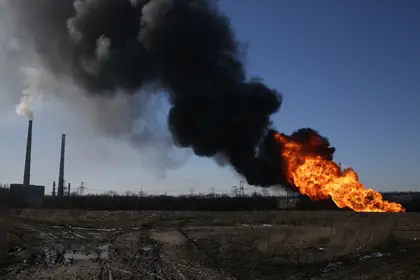“Only
two cars managed to get out of the encirclement yesterday. The guys
say it was just a miracle,” she tells the Kyiv Post as she sits in
the office of medical department of National Guard in Artemivsk on
Feb. 16. “None came out today.”
She
is especially worried about one soldier in particular, her son Albert
Sardasian, who serves in the same medical unit but is currently stationed in
Debaltseve. He transferred there on Feb. 5 for his 12-hour long
shift, but has been trapped ever since.
JOIN US ON TELEGRAM
Follow our coverage of the war on the @Kyivpost_official.
The
cease-fire that came info effect on Feb. 15 brought relief to some Ukrainian troops in the eastern provinces, but not those
stationed around Debaltseve, a city of 25,000 people and an important
railway junction bordering Luhansk and Donetsk oblasts.
Ukraine’s defense ministry said on Feb. 17 that separatists had seized part of the strategic town of Debaltseve from government troops and that street fighting was taking place between the two sides despite the cease-fire deal.
The
main road that connects Debaltseve and Artemivsk, the nearest city fully
under Ukrainian control, is mined and shelled by enemy tanks and
missile systems. Ironically, it’s referred to by troops as “the road of
life.” Soldiers now have to use a side road through the fields, which
is no less dangerous.
Speaking
to the Kyiv Post by phone, Sardasian said he witnesses many deaths
and injuries each day. He said the cease-fire, which was the main
point of the Minsk agreement between leaders of Ukraine, Russia,
France and Germany on Feb. 12, only lasted about 40 minutes.
“It
became quiet abruptly at midnight on Feb. 15 and we even started
hoping for truce,” he said. “But it wasn’t yet 1 a.m.
when the shelling resumed.”
Debaltseve
was a key bone of contention during hours of negotiations between the leaders of France, Germany, Russia and Ukraine during their all-night negotiations that led to the ceasefire agreement.
Just
before the negotiations started in Minsk, another battle took place
place in the area. Separatists attacked the village of Lohvynove,
located on the “road of life” between Debaltseve and Artemivsk
and easily captured it with the help of a Russian tank on Feb. 9.
There were only four Ukrainian soldiers present there at the time.
Three
days later the Ukrainian troops tried to recapture the village, using
armored personnel vehicles, but were ambushed, according to
soldiers stationed in the area.
“The
meat
grinder in Lohvynove was worse than even those in Donetsk and Luhansk airports,” said Vitaliy, a Ukrainian soldier, who was helping to
evacuate the wounded on Feb. 12. “We had to leave our dead there as
it was impossible to evacuate (bodies) under fire,” he said.
The
hospital in Artemivsk alone tended to 96 wounded soldiers after that
fight, Neshchadym said. The pro-Russian rebels were shelling
ambulances, burning at least two of them. Only two out of 15 vehicles
available for military medics in Artemivsk are still usable,
according to medical driver, who goes under the nom-de-guerre
Kapelan.
Video
footage released by Russia 24 TV showed a burned armored vehicle and
dead bodies of Ukrainian soldiers still lying on the ground in
Lohvynove on Feb. 15.
Vitaly,
the soldier who witnessed the carnage, is sure that it was the
Russian regular troops that ambushed the
Ukrainians in Lohvynove. “They were obviously not the farmers from
DNR (self-proclaimed Donetsk People’s Republic),” he said.
Just
after the Minsk talks ended, Russian president Vladimir Putin said
that the Ukrainian troops around Debaltseve must put down their
weapons and stop fighting there. Separatist leader Aleksandr
Zakharchenko claimed on Feb. 16 that the area wasn’t part of the
ceasefire deal and said the Ukrainian troops could only leave the
area unarmed.
The
Ukrainian General Staff has consistently reported in the past days
that the situation was tough but it was still possible to deliver
food and weapons to the Ukrainian forces in and around Debaltseve. By
various estimates, between 4,000 and 8,000 Ukrainian troops remain
there as of Feb. 17.
Andriy
Lysenko, the government military spokesman, said
on Feb. 10 that Debaltseve has become a “kind of a symbol of heroic
resistance.”
Previously,
the same label was used to describe the Ukrainian soldiers and
volunteers fighting in the Donetsk airport. The fighters themselves
were dubbed “cyborgs” for their impressive resistance inside the
encirclement of separatists troops.
But
in January the Ukrainian soldiers had to retreat from the airport
after the concrete building collapsed from constant shelling, killing
and wounding dozens.
Soldiers,
medics and volunteers interviewed by the Kyiv Post in Artemivsk were
adamant that the situation with the Ukrainian forces in Debaltseve
was more serious than the military commanders admitted.
“This
is like another Ilovaisk pocket but much bigger in terms of number of
people and scope of operation,” said Guy, a soldier of the Donbas
Battalion, whose volunteers are also fighting in the area. Ilovaisk
is a reference to a deadly trap in August that killed thousands of
Ukrainian troops.
Speaking
from Debaltseve, Sardasian, the military medic, said that the
Ukrainian soldiers spend the days hiding from shells and waiting for
the order from their commanders.
His
mother Neschadym is trying to figure out how to resume evacuation of
the wounded and bring her son back. “I don’t understand what is
their (commanders’) plan for now. And nobody can,” she said.
Kyiv
Post staff writer Oksana Grytsenko can be reached
at [email protected]
Editor’s Note: This article has been produced with support from www.mymedia.org.ua, funded by the Ministry of Foreign Affairs of Denmark and implemented by a joint venture between NIRAS and BBC Media Action. Content is independent of the donor.
You can also highlight the text and press Ctrl + Enter




